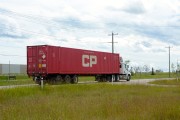The House of Commons environment commitee is in the midst of hearings on Canada's plan to implement the Kyoto Protocol. The committee is waiting to hear from Natural Resources Minister John Efford, who is in charge of many of Canada's Kyoto implementation programs.
While Efford told the Hill Times (April 5) that Kyoto implementation is proceeding according to plan, the reality is that the program at the very core of the federal Kyoto plan risks being hobbled by a series of loopholes that significantly threaten Canada's ability to meet its international obligations.
[subscribe:moo,align=right]
Nearly half of Canada's greenhouse gas emissions come from major industrial facilities like coal-fired power plants and oilsands operations. These emissions are rising fast. Between 1990 and 2001, Canada's emissions from electricity generation rose by 44%, and emissions from oil and gas production and distribution by 50%. Curbing emissions of these "large final emitters" (LFEs), as the government calls them, is the single most important policy initiative Canada needs to implement Kyoto.
A proposed system of emissions targets for LFEs is, by far, the biggest single component of the federal Climate Change Plan for Canada. The LFE system proposes to reduce emissions by 55 megatonnes, or nearly a quarter of Canada's Kyoto target. Efford's officials are now preparing legislation to put this system in place and are hoping to table it in Parliament by the end of this year. This deadline is important both to minimize uncertainty for industry and ensure the system is in place by 2008, the year when Canada's Kyoto target begins to apply.
Under the LFE system, several hundred industrial facilities across Canada will face regulated emissions targets. Facility owners will be able to meet their targets by reducing their own emissions or by buying emissions credits in the emissions trading market. As long as those credits represent genuine emission reductions, this will be a cost-efficient way to meet our emissions targets.
But if companies are given credit for measures that do not truly reduce emissions, the system will not work, and our targets will not be met.
The problems lie in the way Natural Resources Canada (NRCan) officials are negotiating targets with industry sectors behind closed doors. Electricity generation is the only LFE sector for which proposed targets have been made public. The lack of transparency in negotiations with other sectors makes effective scrutiny of the emerging LFE system impossible.
Getting the LFE system right is critical because if loopholes result in companies only appearing to reduce emissions, without actual reductions taking place, Canada will have to find another way to make these reductions, likely at a significant cost to taxpayers.
Under the Climate Change Plan for Canada, Canada must reduce its emissions relative to the projected level of emissions in 2010. NRCan is currently calculating what the projected levels would be for each industry sector, and is likely under intense pressure from industry to increase them. Any increase will allow a higher level of industrial emissions than foreseen in the Plan, thereby placing the burden of Kyoto reductions elsewhere.
NRCan officials are also pursuing LFE targets that ignore how other programs in the Plan reduce industrial emissions. As a result, industrial reductions will be double counted — once under those programs, and then a second time under the LFE system.
If industry lobbying is successful, another form of double counting will occur when LFEs buy "offset" credits. Under the Plan, each company is given the option of reducing its own emissions, or if it is less costly, it can pay to reduce their emissions in non-LFE sectors — agriculture, for example. Either way, a reduction takes place. But if the reduction is double counted, such that the company receives an "offset" credit under the LFE program while the reduction is already counted under another program in the Plan, there will be a shortfall in those programs' ability to meet their targets.
Perhaps the most worrying loophole in the LFE system arises from the government's proposal to set targets for LFEs in terms of "emissions intensity" (emissions per unit of industrial production), despite Canada's Kyoto target being based solely on actual emissions. Using emissions intensity as the basis means that if industrial production is higher than expected, overall emissions will rise above our targets.
The present government made a clear promise in the Throne Speech to cut greenhouse gas emissions and to meet our Kyoto obligations. But it cannot do this if the centrepiece of Canada's Kyoto plan is threatened by serious loopholes. Minister Efford must ensure that his government's Kyoto commitment is not undermined by these loopholes.






